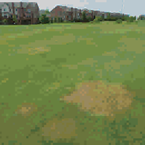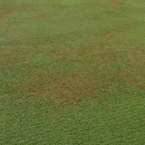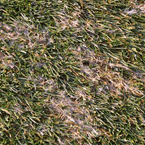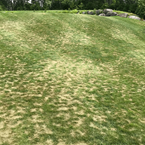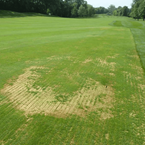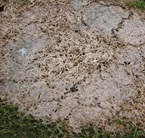// Problem
Optimum air temperature for shoot growth for cool-season grasses is 15-24 °C and optimum soil temperature for root growth is 13-17 °C. Shoot growth ceases when air temperature is above 32 °C and root growth ceases when soil temperature is above 25 °C. These temperatures are often exceeded on creeping bentgrass and annual bluegrass putting greens during the summer. The high temperatures cause the roots of cool-season grasses to decline and the growth of new roots to be inhibited. The declining roots are more susceptible to root rotting fungi and other stresses, while the new roots do not grow to replace the old roots. Summer decline symptoms can include poor turfgrass vigour, chlorotic turf, reduced density, diminished root system, disease activity, and overall inferior turf quality.
Implementing proper cultural practices is crucial to alleviating turf stress during the summer. Management tactics that encourage root growth will help to reduce the damage including: aerifying throughout the summer with needle tines or spikers, syringing to lower canopy temperature, improving air movement by removing trees or using fans around the greens, spoon feeding with water-soluble nutrients, and raising mowing heights to increase photosynthetic activity.
A preventive fungicide program has been shown to be very helpful in managing summer decline. Fungicide applications should be initiated in late-spring/early-summer prior to the onset of summer stress and continued throughout the summer months.
// Envu Solutions
Implementing proper cultural practices is crucial to alleviating turf stress during the summer. Management tactics that encourage root growth will help to reduce the damage including: aerifying throughout the summer with needle tines or spikers, syringing to lower canopy temperature, improving air movement by removing trees or using fans around the greens, spoon feeding with water-soluble nutrients, and raising mowing heights to increase photosynthetic activity.
A preventive fungicide program has been shown to be very helpful in managing summer decline. Fungicide applications should be initiated in late-spring/early-summer prior to the onset of summer stress and continued throughout the summer months. Signature XTRA Stressgard provides plant health effects and should be tank-mixed with other fungicides to control both biotic and abiotic factors that contribute to summer decline.
// Resources

